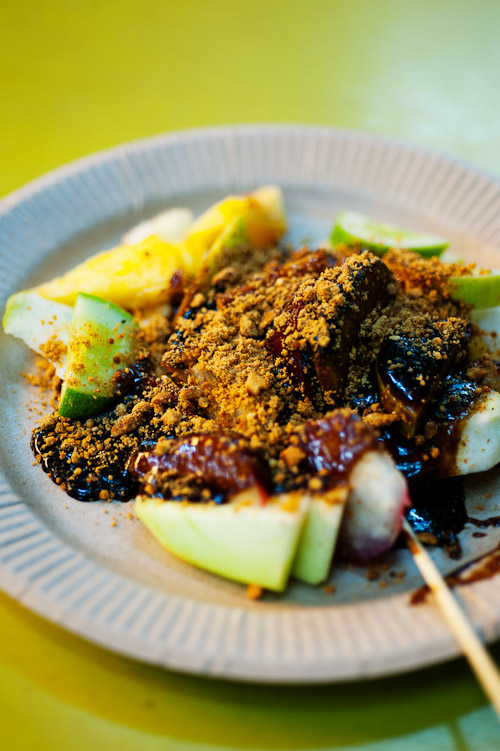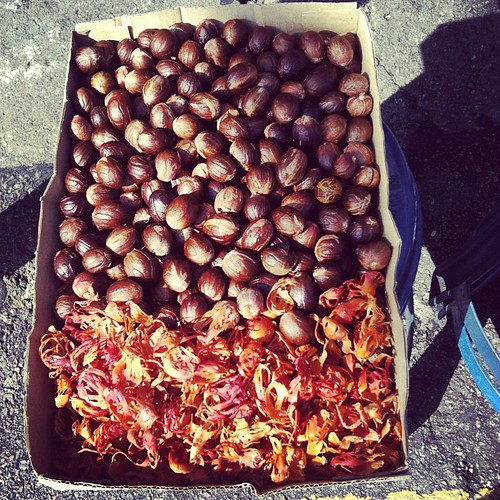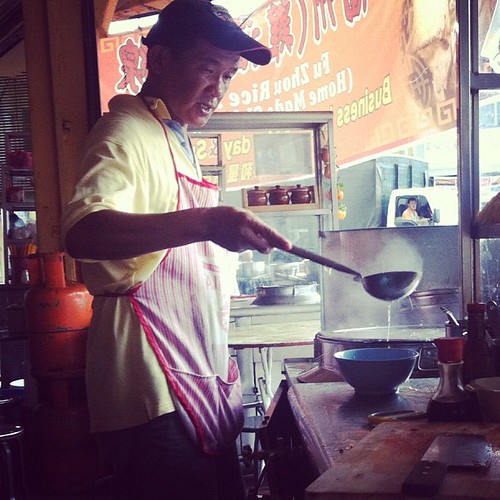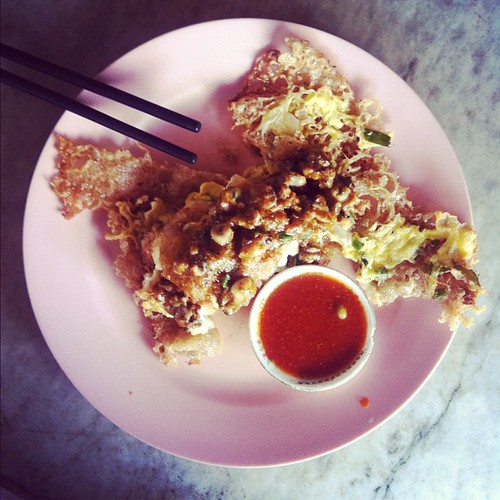Georgetown, March 12, 2012
Fried noodles
 It being a predominately Chinese town, noodles are just about everywhere in Georgetown. In particular, I fell for the city's fried noodles -- a dish I don’t eat too often in Thailand -- and two types stand out in my mind.
It being a predominately Chinese town, noodles are just about everywhere in Georgetown. In particular, I fell for the city's fried noodles -- a dish I don’t eat too often in Thailand -- and two types stand out in my mind.
Char koay teow gets my vote for Malaysia’s -- if not Asia’s -- tastiest fried noodle dish. It combines koay teow, flat rice noodles, with thin slices of Chinese sausage, cockles, prawns, egg and bean sprouts:
The dish is seasoned with soy sauce and a paste made from dried chili -- no sugar here. Some fry the noodles with vegetable oil, although many still fry with lard; one famous vendor’s mise en place includes a huge bucket of the stuff:
View Thai Eats in a larger map
Allegedly she’ll throw a few chunks of crispy pork fat into the mix upon request.
The dish is rich, oily, a bit spicy and if, like the vendor pictured at the top of this post, fried over charcoal, smoky. Char koay teow is available all over Georgetown and although there are a few ‘famous’ vendors, it’s pretty much tasty wherever you eat it.
View Thai Eats in a larger map
Penang Heritage Food and Rasa Malaysia both include recipes for char koay teow.
The other Malaysian fried noodle dish that I couldn't get enough of is mee goreng. It’s an interesting dish, in that it employs Chinese-style ingredients (noodles, beansprouts, tofu), but is predominately made by Muslims of Indian heritage. These ingredients are fried with potatoes, deep-fried bits and egg. It’s generally quite rich and heavy, though despite the dark red colour of the dressing, relatively mild in flavour. This streetside vendor’s version bordered on bland:
View Thai Eats in a larger map
while this vendor’s version, sold near the Pulau Tikus Market, was just a bit spicy, and included lots of crispy deep-fried shallots:
View Thai Eats in a larger map
EatingAsia led me to yet another vendor’s version, which is topped with slices of squid cooked in a slightly spicy sambal:
View Thai Eats in a larger map
Recipes for the mee goreng can also be found in Penang Heritage Food and at Rasa Malaysia.
Georgetown, March 10, 2012
Penang Heritage Food
 On the one hand, wrapping my head around Penang's food has been easy: it's ubiquitous and delicious. On the other hand, the disparate blend of cuisines that have come to define the island's food -- Hokkien, Cantonese, Hainanese, Teo Chew, Indian, Malaysian, English, Peranakan -- is somewhat more complicated. Luckily, there's a great resource. Pointed in the right direction by Robyn, I picked up a copy of Penang Heritage Food, written by a native of Penang, Ong Jin Teong.
On the one hand, wrapping my head around Penang's food has been easy: it's ubiquitous and delicious. On the other hand, the disparate blend of cuisines that have come to define the island's food -- Hokkien, Cantonese, Hainanese, Teo Chew, Indian, Malaysian, English, Peranakan -- is somewhat more complicated. Luckily, there's a great resource. Pointed in the right direction by Robyn, I picked up a copy of Penang Heritage Food, written by a native of Penang, Ong Jin Teong.
Teong lives in Singapore, but was in Penang during my visit, and I got the chance to meet him and talk about the food of Penang and about his book. I mentioned the fact that his book seemed very personal, and he told me that most of the recipes came from his mother. He explained that she used to give cooking demonstrations, and in doing so, recorded many of her recipes. It's these dishes, via a great deal of trial and error, that eventually became his book. Adding to the personal feel are the family photos, and amazingly, even a few old photos of the food vendors and hawkers his family used to be fond of, interspersed with the recipes.
We also had a couple meals together, but as mentioned previously, had bad luck with restaurants and hawkers being unexpectedly closed. Luckily, the delicious Hokkien mee vendor in Pulau Tikus was open, and I was able to score one of their last bowls -- this at about 9AM:
Otherwise, we were forced to try a few new places (or at least places new to us), not many of which were so great. But some were interesting.
At a Hainanese restaurant in Georgetown's Little India, we sat down to a lunch of chicken chop (pictured at the top of this post). Teong explained that in the past, Chinese who emigrated from the island of Hainan were the cooks of choice for wealthy colonial families. Later, they took their experience in the food industry and worked as professional restaurant cooks and opened restaurants. In doing so, they continued to make many of the quasi-Anglo dishes -- chicken chop, curry puff, min chee, macaroni pie, chicken pie -- they had cooked previously. These dishes can still be found at a handful of Hainanese restaurants in Georgetown, many of them served with Worcestershire sauce as a condiment.
Compared to Hokkien mee, I can't say that the chicken chop could compete in flavour, but the fact that both of these disparate dishes have been available here for decades, and are considered part of Penang's cuisine, is fascinating.
For recipes for Hokkien mee and Hainanese/English dishes, and more detailed background about the influences and ingredients that make up the food of Penang, refer to Penang Heritage Food.
Rojak Ho Wei Jeng
 I'd been told by Bee and others that the rojak at the Esplanade hawker centre was worth investigating. I went there two times, but no rojak. In fact, despite how much I've been raving about the food on Penang, eateries being closed has been a theme of my time here. Vague opening hours, no-show vendors and inexplicable closures have seemingly been working against me, and I've probably only been successful in visiting half of the restaurants/stalls/vendors recommended to me.
I'd been told by Bee and others that the rojak at the Esplanade hawker centre was worth investigating. I went there two times, but no rojak. In fact, despite how much I've been raving about the food on Penang, eateries being closed has been a theme of my time here. Vague opening hours, no-show vendors and inexplicable closures have seemingly been working against me, and I've probably only been successful in visiting half of the restaurants/stalls/vendors recommended to me.
But on my third visit there was rojak, and man was I glad I hadn't given up.
Rather than mix the fruit and dressing together in a bowl, as most vendors seem to do, the dressing at Ho Wei Jeng is simply drizzled over the bite-sized chunks of cucumber, guava, rose apple, jicama, pineapple and sour mango (no squid or deep-fried dough here). I'm generally not a huge fan of sweet flavours, but the pleasantly sugary -- almost chocolate-like -- dressing here was amazing, and I didn't miss the shrimpy savoriness that seems to dominate most versions I've tried.
Rojak Ho Wei Jeng Esplanade Hawker Centre (Padang Kota Lama) Jalan Tun Syed Sheh Barakbah, George Town, Penang, Malaysia. Dinner Tues-Sun
View Thai Eats in a larger map
Sup Hameed
 By day, Sup Hameed is a rather bleak nasi kandar restaurant (more on this type of Malaysian restaurant later). Come night, they set out tables and a cart with several huge pots of sup -- rich, meat-based Malaysian soups.
By day, Sup Hameed is a rather bleak nasi kandar restaurant (more on this type of Malaysian restaurant later). Come night, they set out tables and a cart with several huge pots of sup -- rich, meat-based Malaysian soups.
My favourite is sup kambing, goat soup (pictured above), but Hameed's oxtail soup is also good. They also do a quail version, in which the whole birds are added to a bowl of broth. Regardless of the protein, other than some subtle dried spices, a bit of turmeric and a pinch of deep-fried crispy shallots, the predominate flavour here is meat. This contrasts with the Thai version of the dish -- the nearest equivalent being the Thai-Muslim sup haang wua, oxtail soup -- which is generally mouth-puckeringly sour, most likely the result of the Thai desire to pack every flavour possible into a dish.
The dish is served on its own or with a couple slices of white bread. If you need more flavours, try Sup Hamid's teh halia, ginger tea: it's sweet enough to be dessert.
Sup Hameed 48 Jalan Penang, Georgetown, Penang, Malaysia Dinner
View Thai Eats in a larger map
Duck koay chiap
 I've spent the last few nights in a hotel on Lebuh Kimberley. I wasn't previously too familiar with this corner of Georgetown, but it's turned out to be a great place to stay, as there's a lot of interesting stuff to eat just steps from my door: Goh Huat Seng, an old-school Chinese restaurant next door, comes recommended by Bee and is virtually full every night; there's a busy morning market one block away; there's a promising-looking char kuay teow vendor just down the block; and next door to my hotel, a busy and allegedly renowned vendor selling duck koay chiap.
I've spent the last few nights in a hotel on Lebuh Kimberley. I wasn't previously too familiar with this corner of Georgetown, but it's turned out to be a great place to stay, as there's a lot of interesting stuff to eat just steps from my door: Goh Huat Seng, an old-school Chinese restaurant next door, comes recommended by Bee and is virtually full every night; there's a busy morning market one block away; there's a promising-looking char kuay teow vendor just down the block; and next door to my hotel, a busy and allegedly renowned vendor selling duck koay chiap.
I was tipped off to the latter dish via a recommendation from food writer CK Lam in the guidebook I'm updating. But upon reading it, I did a double take, because in Thailand -- at least as far as I'm aware -- kuay jap, as the Thai version is known, is made exclusively with pork (for more on the Thai version, go here).
The dish is prepared by friendly and rather portly family:
and appears to be very popular, with the open-air shophouse 'dining room' full of diners virtually every time I've walked by.
I expected the dish to be sweet -- duck dishes in Thailand usually are -- but it was predominately rich and meaty, with a slight peppery spiciness that reminded me of the Thai version, and just a hint of 'sweet' spice (cinnamon, star anise, clove, etc.). I asked for a 'mixed' bowl, which included duck intestines and other offal, eggs, tender duck meat and a generous amount of duck fat. Like the Thai version, the dish was served with wide rice noodles that resemble tiny carpet rolls; as illustrated in CK Lam's blog, the noodles are still made by the proprietor himself. Unlike Thai kuay jap, a bowl is served with spicy/sour dipping sauce made from fresh chilies.
I'd be curious to learn more about this dish: Is it Hokkien in origin? Teochew? Do Chinese-Malaysians do a pork version?
Duck Koay Chiap Lebuh Kimberley, Georgetown, Penang, Malaysia Dinner
View Thai Eats in a larger map



































